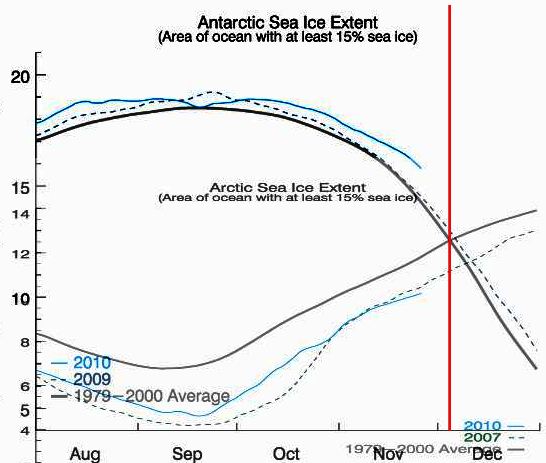Normally, Arctic sea ice extent surpasses Antarctic extent in early December, but it isn’t going to happen this year. Antarctic ice is 1.7 million km² above normal, and Arctic ice is below normal by the same amount. Based on current trajectories, it appears that the crossover will occur in late December.
However, this graph doesn’t give the full story. Colder weather is settling in over the Hudson Bay and Chukchi Sea, so we should see the Arctic line turn sharply upwards during the next two weeks. Look for a positive anomaly of global sea ice in the near future.
That is what climatologists call a “meltdown.”



Care to comment on why the UIUC web pages only show antarctic ice at + 677K ???
They are measuring area. NSIDC measures extent. Extent is always greater than area.
Slaying the Sky Dragon
http://climaterealists.com/index.php?id=6724
Is Phil Jones of Blackburn Rovers taking a lead from his CRU namesake?
He spent today’s entire match defending but his team still managed to let in 7 goals.
Hey Ho!
His fullback passing the ball to Berbatov in front of the goal doesn’t help.
Fergie and Big Sam are old pals, but not that friendly!
You have a trip up to the frozen north tomorrow, at present match still on but more global warming forecast for Newcastle tonight.
Have fun.
I have it on good authority that snow is a thing of the past.
Could large volcanic eruptions contribute to the arctic ice melt?
“Recent massive volcanoes have risen from the ocean floor deep under the Arctic ice cap, spewing plumes of fragmented magma into the sea, scientists who filmed the aftermath reported Wednesday.
The eruptions — as big as the one that buried Pompei — took place in 1999 along the Gakkel Ridge, an underwater mountain chain snaking 1,800 kilometres (1,100 miles) from the northern tip of Greenland to Siberia.
Scientists suspected even at the time that a simultaneous series of earthquakes were linked to these volcanic spasms.
But when a team led of scientists led by Robert Sohn of the Woods Hole Oceanographic Institution in Massachusetts finally got a first-ever glimpse of the ocean floor 4,000 meters (13,000 feet) beneath the Arctic pack ice, they were astonished.
What they saw was unmistakable evidence of explosive eruptions rather than the gradual secretion of lava bubbling up from Earth’s mantle onto the ocean floor.
http://strata-sphere.com/blog/index.php/archives/5589